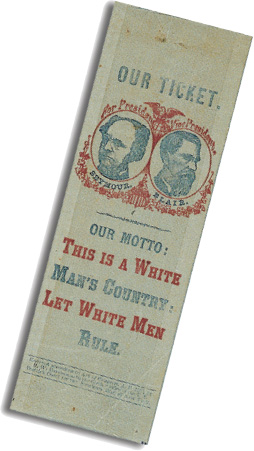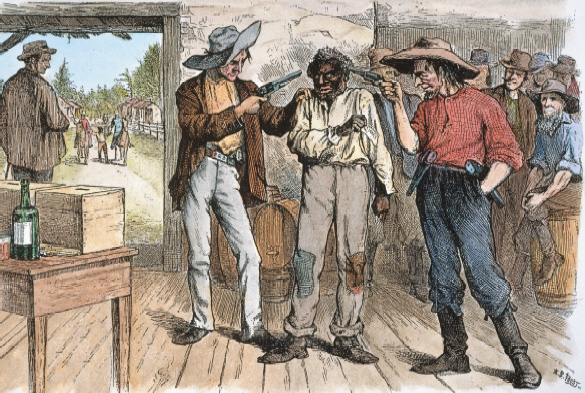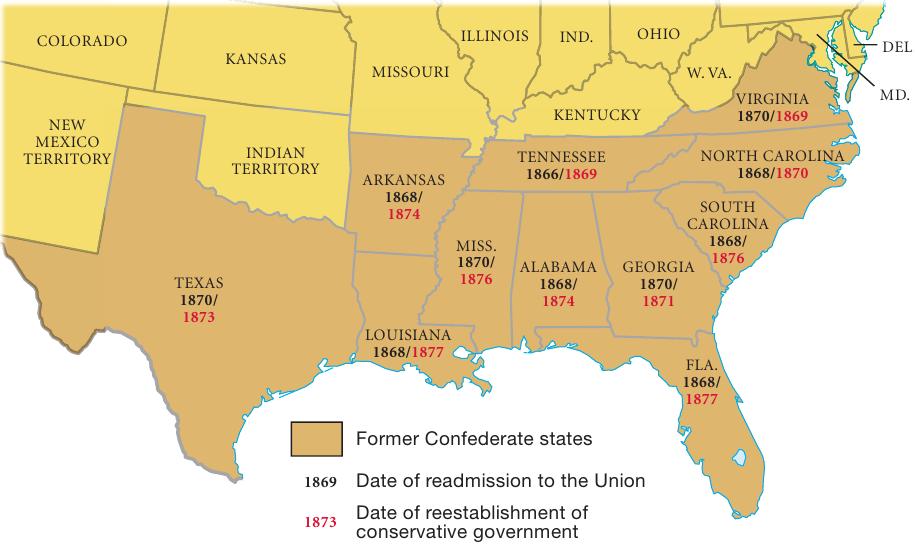1.5.3 White Supremacy Triumphs

Reconstruction was a massive humiliation to most white Southerners. Republican rule meant intolerable insults: Black militiamen patrolled town streets, black laborers negotiated contracts with former masters, black maids stood up to former mistresses, black voters cast ballots, and black legislators such as James T. Rapier enacted laws. Whites resisted the consequences of their defeat in the Civil War by making it clear that military failure did not discredit their “civilization.” They expressed their devotion to all that was good in the South — racial hierarchy, honor, vigorous masculinity — by making an idol of Robert E. Lee, the embodiment of the southern gentleman. They celebrated the “great Confederate cause,” or Lost Cause, by extolling the deeds of their soldiers, “the noblest band of men who ever fought or ever took pen to record.” Southern women took the lead in erecting monuments to the Confederate dead and, with pageantry, oratory, and flowers, in keeping alive the memory of the Lost Cause throughout the old Confederacy.
But the most important way white Southerners responded to the humiliation of reconstruction was their assault on Republican governments in the South, which attracted more hatred than did any other political regimes in American history. The northern retreat from reconstruction permitted southern Democrats to harness white rage to politics. Taking the name Redeemers, Democrats in the South promised to replace “bayonet rule” (a few federal troops continued to be stationed in the South) with “home rule.” They branded Republican governments a carnival of extravagance, waste, and fraud and promised that honest, thrifty Democrats would supplant the irresponsible tax-and-spend Republicans. Above all, Redeemers swore to save southern civilization from a descent into “African barbarism.” As one man put it, “We must render this either a white man’s government, or convert the land into a Negro man’s cemetery.”
527
Southern Democrats adopted a multipronged strategy to overthrow Republican governments. First, they sought to polarize the parties around color. They went about gathering all the South’s white voters into the Democratic Party, leaving the Republicans to depend on blacks, who made up a minority of the population in almost every southern state. To dislodge whites from the Republican Party, Democrats fanned the flames of racial prejudice. A South Carolina Democrat crowed that his party appealed to the “proud Caucasian race, whose sovereignty on earth God has proclaimed.” Local newspapers published the names of whites who kept company with blacks, and neighbors ostracized offenders. One victim proclaimed, “No white man can live in the South in the future and act with any other than the Democratic party unless he is willing and prepared to live a life of social isolation.”

Democrats also exploited the severe economic plight of small white farmers by blaming it on Republican financial policy. Government spending soared during reconstruction, and small farmers saw their tax burden skyrocket. “This is tax time,” a South Carolinian reported. “We are nearly all on our head about them. They are so high & so little money to pay with” that farmers were “selling every egg and chicken they can get.” In 1871, Mississippi reported that one-seventh of the state’s land — 3.3 million acres — had been forfeited for nonpayment of taxes. The small farmers’ economic distress had a racial dimension. Because few freedmen succeeded in acquiring land, they rarely paid taxes. In Georgia in 1874, blacks made up 45 percent of the population but paid only 2 percent of the taxes. From the perspective of a small white farmer, Republican rule meant that he was paying more taxes and paying them to aid blacks.
528
If racial pride, social isolation, and financial hardship proved insufficient to drive yeomen from the Republican Party, Democrats turned to terrorism. “Night riders” targeted white Republicans as well as blacks for murder and assassination. Whether white or black, a “dead Radical is very harmless,” South Carolina Democratic leader Martin Gary told his followers.
But the primary victims of white violence were black Republicans, especially local leaders. Emanuel Fortune, whom the Klan drove from Jackson County, Florida, declared: “The object of it is to kill out the leading men of the republican party.” But violence targeted all black voters, not just leaders. And it escalated to an unprecedented ferocity on Easter Sunday in 1873 in tiny Colfax, Louisiana. The black majority in the area had made Colfax a Republican stronghold until 1872, when Democrats turned to intimidation and fraud to win the local election. Republicans refused to accept the result and eventually occupied the courthouse in the middle of the town. After three weeks, 165 white men attacked. They overran the Republicans’ defenses and set the courthouse on fire. When the blacks tried to surrender, the whites murdered them. At least 81 black men were slaughtered that day. Although the federal government indicted the attackers, the Supreme Court ruled that it did not have the right to prosecute. And since local whites would not prosecute neighbors who killed blacks, the defendants in the Colfax massacre went free.
Even before adopting the all-out white supremacist tactics of the 1870s, Democrats had taken control of the governments of Virginia, Tennessee, and North Carolina. The new campaign brought fresh gains. The Redeemers retook Georgia in 1871, Texas in 1873, and Arkansas and Alabama in 1874. Mississippi became a scene of open, unrelenting, and often savage intimidation of black voters and their few remaining white allies. As the state election approached in 1876, Governor Adelbert Ames appealed to Washington for federal troops to control the violence, only to hear from the attorney general that the “whole public are tired of these annual autumnal outbreaks in the South.” Abandoned, Mississippi Republicans succumbed to the Democratic onslaught in the fall elections. By 1876, only three Republican state governments survived in the South (Map 16.3).

MAP ACTIVITY
Map 16.3 The Reconstruction of the South
Myth has it that Republican rule of the former Confederacy was not only harsh but long. In most states, however, conservative southern whites stormed back into power in months or just a few years. By the election of 1876, Republican governments could be found in only three states, and they soon fell.
reading the map: List in chronological order the readmission of the former Confederate states to the Union. Which states reestablished conservative governments most quickly?
connections: What did the former Confederate states need to do in order to be readmitted to the Union? How did reestablished conservative governments react to reconstruction?
529